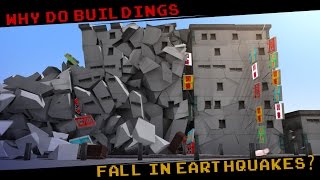(单词翻译:单击)
Earthquakes have always been a terrifying phenomenon, and they've become more deadly as our cities have grown,
地震一直是个很恐怖的现象,当我们城市越发展,地震也造成更多人死亡。
with collapsing buildings posing one of the largest risks.
因为最大的危险之一就是倒塌的建筑物。
Why do buildings collapse in an earthquake, and how can it be prevented?
为什么建筑物会在地震时倒塌呢,如何可以预防建筑物倒塌呢?
If you've watched a lot of disaster films,
如果你看过许多灾难片,
you might have the idea that building collapse is caused directly by the ground beneath them shaking violently, or even splitting apart.
你就可能知道建筑物倒塌,是因为它们下面的地层剧烈摇动或甚至裂开所造成。
But that's not really how it works.
但是其实不是这样的。
For one thing, most buildings are not located right on a fault line,
首先,大多数的建筑物不是在断层线上,
and the shifting tectonic plates go much deeper than building foundations.
而且,移动的板块比建筑物的地基深很多。
So what's actually going on?
所以到底是怎么回事呢?
In fact, the reality of earthquakes and their effect on buildings is a bit more complicated.
事实上,地震的真相和地震对建筑物造成的结果有一点复杂。
To make sense of it, architects and engineers use models,
为了要搞清楚,建筑师和工程师们使用模型,
like a two-dimensional array of lines representing columns and beams,
例如以二维线条代表柱子和梁,
or a single line lollipop with circles representing the building's mass.
或用一条上面有圆形物如棒棒糖的东西代表一个建筑物的质量。
Even when simplified to this degree,
即便如此简单的模型,
these models can be quite useful, as predicting a building's response to an earthquake is primarily a matter of physics.
用来作为预测建筑物在地震时的反应也是很有用的,主要就是一个物理作用。
Most collapses that occur during earthquakes aren't actually caused by the earthquake itself.
多数地震时的倒塌其实并不是因为地震本身所引起的。
Instead, when the ground moves beneath a building, it displaces the foundation and lower levels,
而是,当建筑物下的地层移动时,它使地基和低楼层移位,
sending shock waves through the rest of the structure and causing it to vibrate back and forth.
然后震波传导至整个结构,造成结构前后震动。
The strength of this oscillation depends on two main factors:
震荡的力道主要有两个因素:
the building's mass, which is concentrated at the bottom, and its stiffness,
集中在建筑物底部的质量和它的坚硬度,
which is the force required to cause a certain amount of displacement.
后者是造成某种程度的移位的力量。
Along with the building's material type and the shape of its columns, stiffness is largely a matter of height.
加上建筑物的建材和柱子的形状,坚硬度主要与高度有关。
Shorter buildings tend to be stiffer and shift less, while taller buildings are more flexible.
较低的建筑物比较坚硬,移动程度较小,较高的建筑物移动性就比较高。
You might think that the solution is to build shorter buildlings so that they shift as little as possible.
你可能想那解决的方法就是盖低一点的建筑物,它们的摇动会比较小。
But the 1985 Mexico City earthquake is a good example of why that's not the case.
但是在1985年,墨西哥市地震就是一个证明并非如此的例子。

Durng the quake, many buildings between six and fifteen stories tall collapsed.
在那场地震中,许多6到15楼的建筑物倒塌。
What's strange is that while shorter buildings nearby did keep standing,
奇怪的是附近的较低的建筑物没倒塌,
buildings taller than fifteen stories were also less damaged,
15楼以上的建筑物也损害较少,
and the midsized buildings that collapsed were observed shaking far more violently than the earthquake itself.
那些倒塌的中型建筑物摇摆的程度比地震的震幅还大。
How is that possible? The answer has to do with something known as natural frequency.
为什么呢?答案和自然频率有关系。
In an oscillating system, the frequency is how many back and forth movement cycles occur within a second.
在一个摆动的系统里面,周波数是一秒内来回摆动的次数。
This is the inverse of the period, which is how many seconds it takes to complete one cycle.
这是和一次来回摆动的秒数的周期是相反的。
And a building's natural frequency, determined by its mass and stiffness,
建筑物的自然频率--由它的质量和坚硬度所决定,
is the frequency that its vibrations will tend to cluster around.
是它的震动集中的频率。
Increasing a building's mass slows down the rate at which it naturally vibrates,
当建筑物的质量增加,自然频率降低,
while increasing stiffness makes it vibrate faster.
而坚硬度增加,震动也会加快。
So in the equation representing their relationship,
以一个公式来表现这些之间的关系,
stiffness and natural frequency are proportional to one another, while mass and natural frequency are inversely proportional.
坚硬度和自然频率是成正比,质量和自然频率则是成反比。
What happened in Mexico City was an effect called resonance,
在墨西哥市的地震是共振的结果,
where the frequency of the earthquake's seismic waves happen to match the natural frequency of the midsized buildings.
地震波的频率正好与中型建筑物的自然频率相同。
Like a well-timed push on a swingset,
正如在秋千的最适合点推一下,
each additional seismic wave amplified the building's vibration in its current direction,
接下来的每一个地震波扩大了建筑物往同一方向的震动,
causing it to swing even further back, and so on, eventually reaching a far greater extent than the initial displacement.
造成它更加往那方向的摆动,最后达到比原来更大幅的移位。
Today, engineers work with geologists and seismologists
今天,工程师与地质学家和地震学家共同合作,
to predict the frequency of earthquake motions at building sites in order to prevent resonance-induced collapses,
在建筑物现场预测地震移动的频率,以预防共振引起的倒塌,
taking into account factors such as soil type and fault type, as well as data from previous quakes.
他们考虑土壤类型和断层的类型,以及参考以往地震的数据。
Low frequencies of motion will cause more damage to taller and more flexible buildings,
低频率的震动对比较高和有弹性的建筑物造成更多的损害,
while high frequencies of motion pose more threat to structures that are shorter and stiffer.
反之,高频率的震动威胁到比较低和高坚硬性的建筑物的结构。
Engineers have also devised ways to abosrb shocks and limit deformation using innovative systems.
工程师还提出了吸收震动的方法,以及用创新的系统防止建筑物变形。
Base isolation uses flexible layers to isolate the foundation's displacement from the rest of the building,
地基的隔离是以有弹性的层次,来将建筑物的其他部分从地基的移动隔离开来,
while tuned mass damper systems cancel out resonance by oscillating out of phase with the natural frequency to reduce vibrations.
让调整好的阻尼器系统取消共振,以自然频率消除振荡来降低震动。
In the end, it's not the sturdiest buildings that will remain standing but the smartest ones.
所以最终,不是最坚固的,而是最聪明的建筑物,可以屹立不倒。


